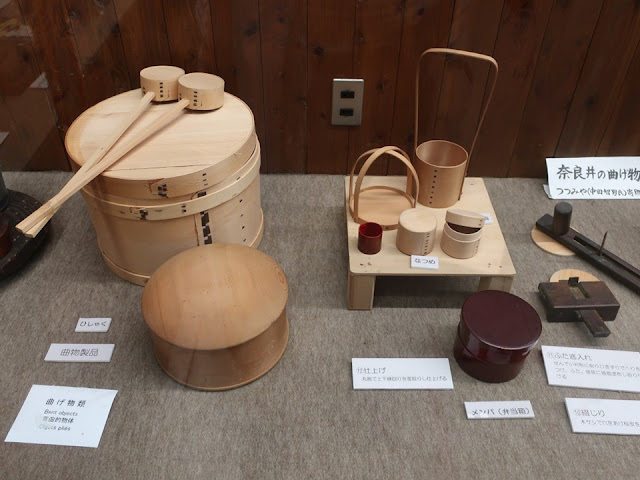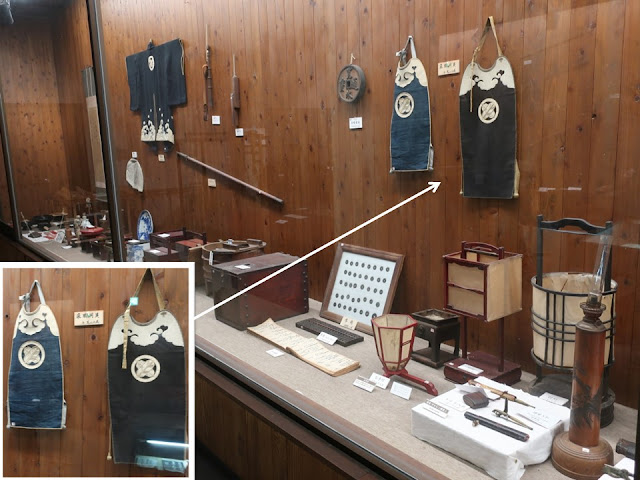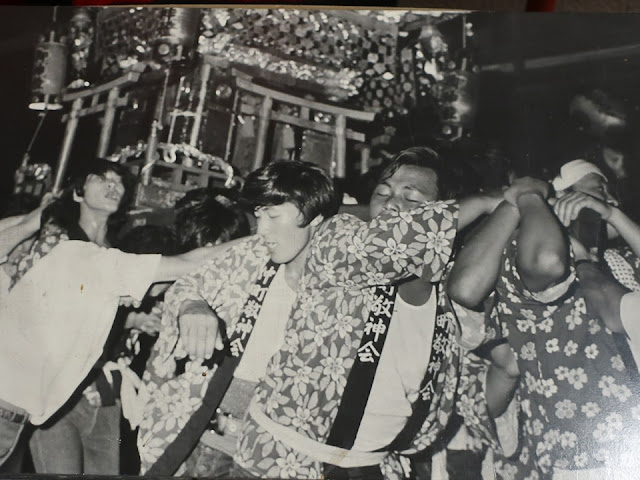The museum is at Narai post-town in Nagano prefecture of central Japan. It was on Nakasendou highway which linked Edo (old name of Tokyo) and Kyoto. There is no big fire since the 19th century, so old town still remains. Therefore, Narai is a popular tourist spot along with Tsumago and Magome which were also post-towns on Nakasendou highway.
Narai people have a traditional festival
in summer. Young people back to their home town
during the festival and hold it. It’s very nice to love and keep their
tradition.
Narakawa, Historical and Folkloric Museum 、楢川歴史民俗資料館
The museum is at the south end of the post-town. It is next to the shrine in which the festival is held.
奈良井宿の南端、鎮守の鎮(しずめ)神社に隣接しています。
Old utensils and furniture on the first floor、民具の展示(一階)
Lunchbox for children, especially for a cherry-blossom-viewing is exhibited. It’s small and so cute. An irori fire place was used until around 1950s, then a kamado kitchen stove took place. Thereafter, oil was used as fuel. Now, gas is used mainly. Irori and kamado disappeared.
子供用の花見弁当。かわいいですね。
囲炉裏とその機能の変遷について、詳しく説明されています。お年寄りは、朝起きて火を起こし、若い人が起きてくる前にお茶を飲むのがひとつの楽しみでした。昭和20年代から30年になると囲炉裏を潰す家が多くなりました。かまどでは、ご飯を炊いたり鉄瓶をかけたりしました。生活改善運動で、昭和30年代半ばに石油コンロ、40年代初期にプロパンガスが普及しはじめ、かまどもなくなりました。
The cupper kamado kitchen stove used wood as fuel. It boiled water with remaining heat.
銅製のトキワカマドは余熱で湯を沸かします。左は水がめと水を汲んでくる桶。
Folklore and history exhibition on the second floor、民俗と歴史の展示(二階)
The exhibition room is larger than the one on the 1st floor. 二階は広い展示室です。
Festival of the village shrine、鎮神社(氏神)の祭礼
It is held in August. Villagers gather at Shizume shrine after the noon. They transfer the deity to the portable shrine (mikoshi) and parade in the town.
祭りは、8月に行われます。昼過ぎに、神社に勢揃いした氏子は、御神体を神輿に移し、町中を神幸します。
The order of the procession is according to the tradition. Towner welcome the deity in a room which faces the road; they open doors. They also offer sake (alcohol) and finger food to the people in the procession.
行列の順序は決まっていて、人々は通りに面した部屋の戸を開け、座ってお迎えします。行列の人たちに酒肴も提供します。
The procession marches to the north end of the village until the evening. Then, people shoulder only the portable shrine and run to the village shrine which is 1km away. The deity is transferred to the shrine and the festival ends late at night. It’s an enthusiastic one-day-festival.
夜までかけて町を巡行した後、神輿だけが若い衆に担がれ、わずか30分で神社に還幸し、禰宜が本殿に戻します。終わるのは深夜、丸一日をかけた熱い祭りです。
Wooden products、木製品
The manufacturing process of round chip box is explained elaborately. It is made from superior Japanese cypress. The “Narai round chip box” is durable and is specialty of the town.
良質な檜を使った丈夫な「奈良井宿の曲げ物」の製造工程が丁寧に説明されています。
Do you want to buy it?
欲しくなりますね。
The container can warm more than several sake bottles. It is named “Bathtub for warming sake”. Good name! It was probably used at inn.
ネーミングがいいですね。宿場のコーナーに展示されているので宿で使かったのでしょうね。
Post-town、宿場
Travelers pasted their works on the folding screen in the inn. A blind and mute person also did it. Even ordinary people had art literacy back then.
Various utensils of inn are exhibited. The ceramic product at lower left is a pillow. It says intellectuals liked the cool surface especially in summer. I cannot sleep well on that hard pillow probably.
旅人が色紙などを書いて貼っていった六枚折屏風(貼り交ぜ屏風)です。盲唖の方の作もあります。こういうことができたのですねえ。
宿の品々が展示されていますが、陶枕(とうちん、左下)は堅そうですが、よく眠れたのでしょうか。硬く、ひんやりとした感触が文人の間で喜ばれ、夏に使われたということです。
Many articles concerning post-town are exhibited. Hikyaku express messenger wore the outfit at lower left. They relayed and needed only three or four days to bring a letter from Tokyo to Kyoto, which distance is around 500km.
宿場町の道具が並びます。飛脚の服は、浮世絵に出てくるあれですね。江戸から京都まで3~4日でリレーしたといいます。
Old documents such as paper money limited to the post-town are also exhibited.
宿場内で通用した宿場札や古文書などの実物が展示されています。
Work tools、仕事の民具
The belt at upper left was used as a part of water wheel. It says that it was made from elephant skin. Really?
象の皮を素材とした水車ベルトが展示されていました。水車は、櫛を作るときの動力源だったのですが。本物の象ではないですよね、きっと。
Shizume shrine、鎮神社
The shrine is next to the museum. The thing stored in the warehouse (upper left) would be the portable shrine.
資料館の隣は、鎮神社です。蔵の中にあるのがお神輿だと思います(左上)。
People shoulder the portable shrine and run up the steps at the end of the festival.
お神輿が戻る時は、奈良井宿を駆け抜け、階段を上がります。
Shizume shrine festival、鎮神社例大祭(12th of August in 2023)
After the noon, the deity is transferred to the portable shrine and the procession goes down the main road to the end of the town. It often stops, and reaches in the evening.
正午過ぎに神さまをお神輿に載せた行列は、各所で止まりながら半日をかけて奈良井宿を下っていきます。
When the procession stops, they take a break. The family along the road treat them.
行列は、止まった場所で休憩を取り、沿道の家から、飲み物などのもてなしをうけます。
It’s a float of a lion dance. They also take a break. It takes half a day to walk through the town; the distance is only 1km. They have a plenty of breaking time, which strengthen the bond of inhabitants, I think.
迫力ありますね。獅子の山車も休憩を取りながら進みます。約1kmの奈良井宿を半日かけて進みますから、休憩時間が長いです。この長さが人々の繋がりを強めていると思います。
The instrument of the band are drum (taiko and tuzumi), Japanese guitar (shamisen) and Japanese flute (yokobue). It’s a hot season, so an assistant fans the musician with a hand fan. When they don’t proceed, they sit down; everyone has a chair.
太鼓、鼓、三味線、笛の構成です。暑いので、団扇で扇ぐ人が付きます。家から見ている人も暑そう。椅子を持っていて、動くとき以外は座る行列です。
They are vanguards of the portable shrine. The priest is in front of the portable shrine.
お神輿を先導する人たち。お神輿の前には、神主さんがいます。
People shoulder the portable shrine. However, people put a portable shrine on a cart or a truck in many areas because of lack of carriers. Narai people don’t cut corners. Inhibits welcome the deity who is on the portable shrine. I think their energy, passion and bond are strong.
人手が少ない地域ではお神輿は車に載せますが、奈良井では担ぎます。そして、氏子たちが神様を迎える本来の姿があります。祭りを簡略化していない=住民のパワー&繋がりが強いと考えています。
The residents along the road are acquaintances, so they enjoy chatting. I heard a resident asked to a young man, “Long time no see! What do you do now?”. The shinme brings up the rear.
沿道の方は知り合い、会話も弾むようです。「○○くん、今は何をしてるの」という会話も聞こえました。行列の最後尾は神馬です。
The shinme (sacred horse) is very popular. It is a gentle horse, but it is changed every year. It is prohibited to bring a dog near the horse, because it will be upset.
神馬は大人気。手前のバケツは飼い葉桶です。毎年、馬が替わるようです。馬が驚かないように、犬が近づくのは禁止でした。
Families along the road hang a festive lantern and set a space to see the procession and to treat spectators (I took a photo while they were out).
沿道の家は、提灯を下げ、見物と振る舞い用のスペースを設けています(人のいないときに撮影しました)。
The family above set a folding screen. They chatted behind it.
Generally, festival is a nice opportunity for family reunion. In Narai, young people return from city and hold the festival. I could see the good aspects of the festival; people preserve their tradition and it works well.
屏風を立てている家もありました。みなさんは、屏風の裏で歓談中。
祭りは親族が集まる良い機会です。若者たちは都会から戻って来て、祭りを支えているとことです。トラックにお神輿を載せてあっという間に町内を渡御する町もあるなかで、ここでは、旧来の祭りの姿を見ることができます。
After they perform the half day parade, they take off formal clothes (kami-shimo) and put on festive coats (happi). They shoulder the portable shrine and run up to Shizume shrine. Thereafter, the priest returns the deity to the main hall of the shrine; it is at night. It is an enthusiastic one-day festival.
夕方までかけて奈良井駅まで行った後、裃を脱いで法被に着替えた若い衆が神輿を担ぎ、わずか30分で神社に還幸し、禰宜が本殿に戻します。終わるのは深夜、丸一日をかけた熱い祭りです。2023年からは約二時間早くして、19時に還幸するようにしたそうです。
Reference:
Six minute movie (after 3min 35sec, the portable shrine returns)、動画(6分、神輿の還幸は3分35秒後)
https://www.youtube.com/watch?v=KUji2KNS_0Y&t=366s
Reference website、観光協会のウエブサイト:
https://tokimeguri.jp/guide/narakawa-shiryokan/
(in Japanese), accessed in January, 2024
Visited in July, 2023
Previous post (partially rebuilt checkpoint
on Nakasendou highway): Niekawa
ex-checkpoint、贄川関所
Next post (traditional buildings in Narai): Narai post town and Kami-toiya museum、奈良井宿と上問屋史料館




























Comments
Post a Comment